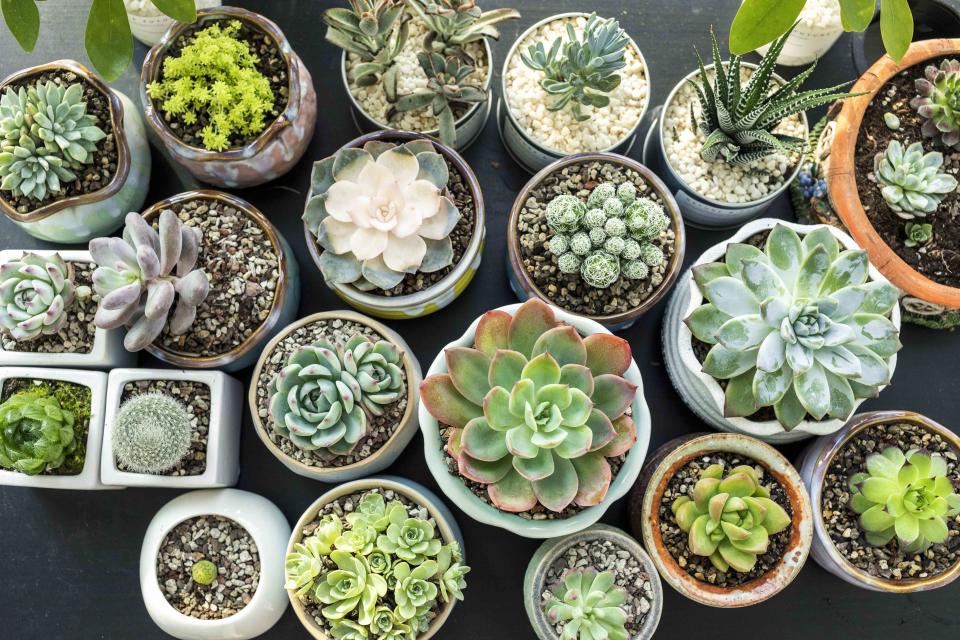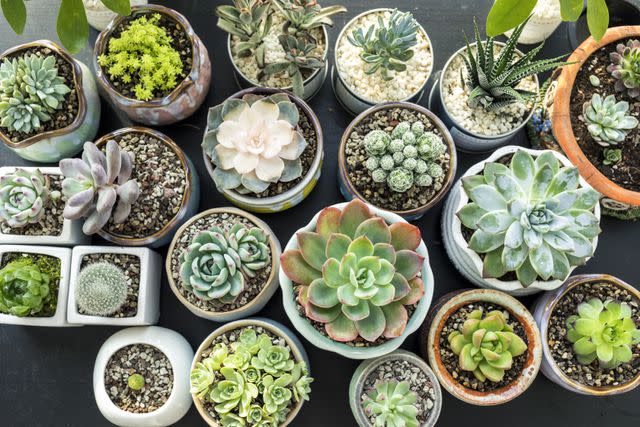How to Care for the Succulents You Grow Indoors
These plants can withstand harsh conditions, but with the right attention, they go from surviving to thriving.

Getty Images
Succulents have a reputation for being troopers. As desert natives, they're accustomed to harsh conditions and capable of surviving both lengthy droughts and extreme temperatures better than many of their plant peers, since they store own water in their signature thick, fleshy leaves and stems (the word "succulent" is derived from the Latin word sucus, meaning "juice").
Just because they're low-maintenance, however, doesn't make them low priority. When they are properly watered, placed in a sunny spot, and tidily pruned, succulents can become some of the prettiest plants in your indoor garden.
Related:The Best Soil Type for Growing Succulents and Cacti

Getty Images
Succulent Varieties to Grow
In warmer, drier parts of the United States, including the west and southwest regions, many types of succulents can thrive outside, including agave, yucca, opuntia, pediocactus. But in areas where temperatures drop below freezing throughout the year, it's important to choose a succulent that's happy with moderate warmth, sunny windowsills, and a well-drained pot, says Scott Preusser, assistant horticultural curator at the Denver Botanic Gardens.
His suggestions include: haworthia, which looks like a mini aloe plant; aloe, a favorite for its health benefits; crassula, known as the lucky plant; rosetta-inspired echeveria; mammillaria, a globe-shaped cactus; star-shaped astrophytum; and echinopsis, also known as a hedgehog or Easter lily cactus. For more varieties to grow indoors, check out our guide to low-maintenance succulents and choose the best option for your home.
How to Grow and Care for Succulents Indoors
Though a succulent's care requirements will depend on the variety you're growing, there are a few general ways to keep this plant type happy.
Sunlight
Although there are some shade-loving varieties, most succulents need light—lots and lots of light. "Generally, succulent plants want as much sun as you can give them, but will tolerate some shade," says Preusser. Choose the brightest spot you can find to bring out the rich colors of your succulents.
Not all homes offer the ideal growing conditions for succulents, though: "If you only have north-facing windows, you probably don't get enough light for most succulents," says Summer Rayne Oakes, founder of Homestead Brooklyn and author of the book How to Make a Plant Love You. For homes that don't receive large amounts of natural light, specialized LED grow lights can help succulents thrive—or you can opt for a variety that survives in darker conditions, such as ox tongue and snake plants.
Soil
Lightweight, premixed succulent soil blends offer better drainage than standard options, which is too dense for delicate, rot-prone succulent roots. Succulent mixes vary, but generally contain a mix of sphagnum peat moss, perlite, and mycorrhizae to promote drainage and prevent soil compaction. "Most general, well-draining soil mixes will work well," says Preusser. "You can make your own cactus mix by adding 30 to 50 percent gravel, lava rock, or perlite to a standard mix. Make sure the container you choose has a drainage hole; I like to top-dress with gravel to finish it off."
Water
Each succulent variety has its own unique watering needs, and environmental factors such as the amount of light and the temperature of the air can affect how much water an individual plant requires. However, Preusser offers a simple rule: "It's always better to be on the dry side," he says. "When in doubt, do without."
When natural light levels are low, mimic the dry-season needs of a succulent plant by watering it about once every two weeks; in the brighter summer months, increase to once a week. Regardless of your watering schedule, pay attention to your plant, especially if it receives intense light. Your soil shouldn't be wet, but it shouldn't look dry and dusty, either, and shriveled leaves are a clear sign that your plant friend needs a drink. "Plants aren't décor," says Oakes. "You have to observe them and see what they need."
Fertilizer
Preusser recommends fertilizing succulents three times during their growing season, once each in May, July, and September, with 15-15-15 fertilizer at one-third the labeled rate. "That way, the nutrients are spread out over a longer stretch of time," he says. If you don't mind a slight ocean scent in your home, he suggests using seaweed extract as an additive. "It's a little stinky, but worth it, and loaded with micronutrients," he says.
Temperature and Airflow
As long as your indoor air temperature stays in a comfortable range, the fluctuation of temperature by season will benefit indoor succulents. "A good general temperature range is 60 to 80 degrees Fahrenheit, and most can take it hotter in summer months," says Preusser. "Many gardeners will move potted plants in and out of a house or greenhouse as cold temperatures allow."
How to Repot Succulents
In their natural environment, succulents often grow in close proximity to each other, says Preusser, so they prefer a tight container and don't need frequent repotting. "I like to repot into the next bigger size gradually, only leaving an inch or two of room between the plant and container edge," he says. "Repotting should be done infrequently and only when a plant outgrows its container or becomes too difficult to water."
Oakes suggests that new gardeners use terra-cotta planters with drainage holes to encourage dry, healthy roots; the clay naturally wicks away moisture, and excess water can escape through the bottom. However, once you're more familiar with succulents and their unique soil and watering needs, you can use almost any vessel, from teapots to dresser drawers.
How to Prune Succulents
When compact, low-growing succulents don't receive enough light, they sprawl upwards trying to find the sun, resulting in an awkward "leggy" appearance. "Plants that have stems can be thinned or cut down at the base to regenerate," says Preusser.
Oakes avoids pruning, letting her leafy friends morph as they grow. "Plants, and succulents especially, will change over time," she says. "You can buy certain types that maintain their cuteness, but then you miss out on a lot of plants. I try not to get obsessed with things looking Pinterest-perfect."
How to Propagate Succulents
Succulents are easy to propagate, says Preusser: "Most cuttings will root easily if put into small pots of dirt." Use a sharp, clean blade to take a fresh cutting—ideally of a stem that's sprouting wispy arial roots off of its side; this is a sign the stem is ready to leave home and put down roots of its own. Place the cutting in a shallow container of soil, then mist—don't overwater—until sturdier roots have developed.
Related:How to Get Rid of Common Houseplant Bugs, According to Experts
Common Problems With Succulents
Succulents are typically hardy and easy to grow, but keep an eye out for these issues—and nip them in the bud before they seriously harm your plant.
Pests
Succulents suffer from few pest problems, especially when kept indoors, but you might see mealybugs, spider-mites, or scale, says Preusser; spot treat these with a Q-tip and rubbing alcohol.
Over-Watering
There is one easy way to kill a succulent: too much water. "Generally speaking, most people are overwatering their succulents," says Oakes. "Many have very sensitive roots." Choose a pot with reliable drainage to help keep delicate roots dry and remember—drier is better.
Burned Leaves
Succulents face one of the same summer health concerns as people: sunburn. If succulents receive an abundant amount of intense light, they may turn pale and go dormant, says Preusser. Luckily, there's an easy fix: If your plants are fading, simply move them further from the window.

